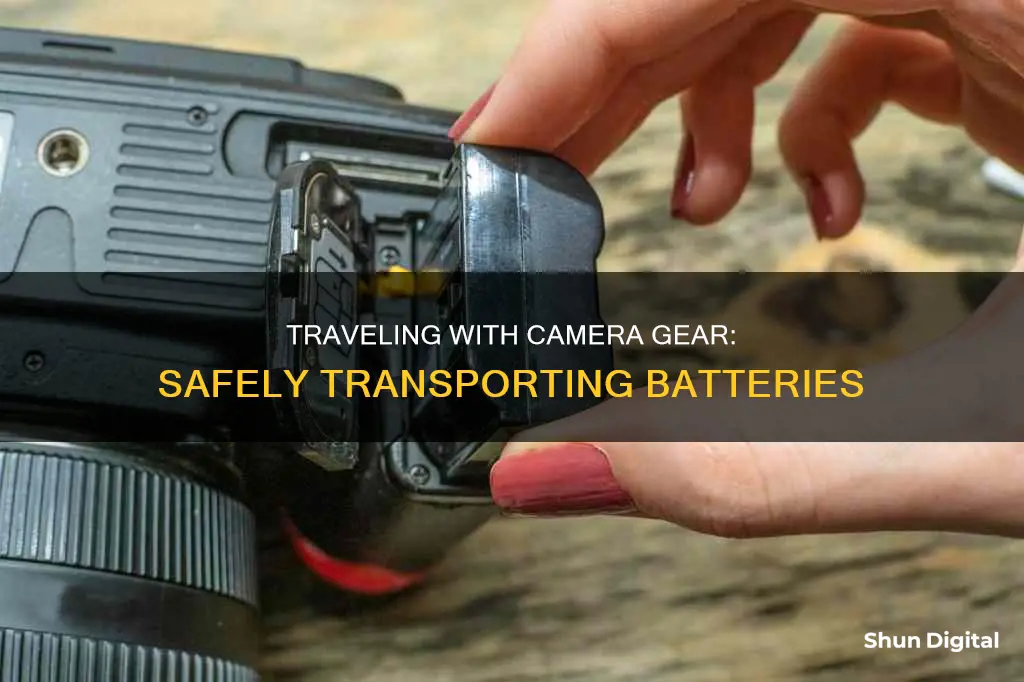
Transporting camera batteries when flying requires careful consideration of safety guidelines to prevent fire-related incidents. The Federal Aviation Administration (FAA) and the Transportation Security Administration (TSA) have implemented rules for carrying different types of batteries on planes. Dry cell alkaline batteries (AA, AAA, C, and D) can be freely carried on board or checked in luggage without quantity restrictions, but they must be protected from damage and short-circuiting. Lithium-ion batteries, commonly used in camera equipment, are allowed in carry-on luggage but must be shielded from harm and short circuits during transport. These batteries should be in their original packaging or have their charging interfaces taped over. Spare lithium-ion batteries should be limited to two per person and must be carried in carry-on luggage, as loose lithium batteries in cargo holds pose a fire risk. Camera batteries over 100 watts are permitted but limited to two, and they must be carried on board. Proper packaging and protection of battery terminals are crucial to prevent short circuits.
| Characteristics | Values |
|---|---|
| Type of batteries | Standard dry cell alkaline batteries (AA, AAA, C, D), lithium-ion batteries, lithium metal batteries |
| Where to store the batteries | Store standard dry cell alkaline batteries in carry-on or checked luggage. Store lithium-ion and lithium metal batteries in carry-on luggage only. |
| Quantity restrictions | No restriction on the number of standard dry cell alkaline batteries. Only two spare lithium-ion or lithium metal batteries allowed. |
| Weight/Watt-hour restrictions | Lithium metal batteries: 2 grams of lithium per battery. Lithium-ion batteries: 100-watt hours per battery. |
| Battery damage | Do not fly with damaged batteries. Dispose of them properly. |
| Battery packaging | Tape the battery terminals or use the manufacturer's packaging to prevent short circuits. Store batteries in their original packaging or a protective case/plastic bag. |
| Battery chargers | Allowed in carry-on and checked bags. Wrap the electrical cord around the charger. |
What You'll Learn

Tape battery terminals or use manufacturer's packaging
When flying with camera batteries, it is important to take precautions to protect the battery terminals and prevent short circuits. One effective way to do this is by taping the battery terminals or using the manufacturer's packaging. Here are some detailed instructions and considerations for this method:
Firstly, it is recommended to use tape designed for electrical purposes, such as electrical tape or insulating tape. These types of tape provide effective insulation and will not leave any sticky residue on the battery terminals. Avoid using duct tape or parcel tape, as they can damage the batteries and leave marks.
When applying the tape, ensure that you cover the charging interfaces or connectors completely. This will help prevent accidental activation and protect against short circuits. It is also advisable to place each battery in its own protective case or plastic bag before taping the terminals. This provides an additional layer of protection and makes it easier to identify and handle the batteries during security checks.
If you prefer not to use tape, you can utilise the manufacturer's packaging. Most batteries come in boxes or plastic cases that are specifically designed to protect the terminals and prevent accidental activation. This method ensures that the batteries remain safe and secure during transport.
In addition to taping the terminals or using the manufacturer's packaging, it is recommended to store the batteries in separate bags. This further reduces the risk of short circuits and provides easy access for customs checking.
By following these guidelines, you can help ensure that your camera batteries are transported safely and securely when flying. Remember to also familiarise yourself with the specific regulations of the airline and the country you are travelling to, as there may be additional requirements or restrictions for carrying camera batteries.
Testing Camera Battery Chargers: A Step-by-Step Guide
You may want to see also

Keep batteries in carry-on luggage
Keeping batteries in your carry-on luggage is the best way to ensure they are transported safely and securely. Lithium batteries, which are commonly used to power cameras, can catch fire if damaged or short-circuited. Therefore, it is important to keep them in your carry-on baggage, where you can monitor them and quickly address any issues.
When packing your camera batteries, it is important to take precautions to prevent short-circuiting. Cover the battery terminals with tape or use the manufacturer's packaging to protect them. Additionally, place each battery in a separate bag to provide further protection. If you are travelling with spare batteries, consider placing each one in its own protective case or plastic bag.
It is also important to note that there are weight and size restrictions for lithium batteries. For lithium-ion batteries, the limit is 100-watt hours per battery, while for lithium-metal batteries, the limit is 2 grams of lithium per battery. These restrictions cover most lithium batteries used in everyday electronic devices, including cameras. However, with airline approval, you may be able to carry larger batteries.
By following these guidelines, you can help ensure that your camera batteries are transported safely and securely when flying. Keeping them in your carry-on luggage allows for easy access and quick response in the event of any issues.
Is Your SQ8 Camera Charged? Check This Way
You may want to see also

Limit two spare lithium-ion batteries per passenger
When flying with camera equipment, it's important to be aware of the regulations surrounding lithium-ion batteries. While you can bring your rechargeable lithium-ion camera batteries on a flight, there are specific rules in place for the safety of everyone on board.
Firstly, it's important to note that there is a limit of two spare lithium-ion batteries per passenger. This means that, in addition to any installed lithium-ion batteries in your devices, you can carry a maximum of two extra batteries in your carry-on luggage. These spare batteries must be protected from potential damage and short circuits.
To prevent short circuits, you should ensure that the battery terminals are covered. This can be done by keeping the batteries in their original packaging or by taping over the charging interface or contacts. By taping the terminals or using the manufacturer's packaging, you can reduce the risk of accidental activation during transportation.
It is also recommended to place each battery in a separate bag or protective case to provide additional protection. This helps to prevent the batteries from coming into contact with metal items or other batteries, reducing the risk of short circuits and potential fires.
In addition to the quantity limit, there are also size restrictions for lithium-ion batteries. The watt-hour rating of the battery determines whether it falls within the allowable range. Most lithium-ion batteries used in common electronic devices, including cameras, fall within the limit of 100 watt-hours per battery.
However, if you need to carry larger batteries, those rated between 101 and 160 watt-hours, you will need to seek approval from the airline. With their permission, you can carry up to two of these larger lithium-ion batteries in your carry-on luggage.
Disney's Camera Battery Chargers: A Photographer's Lifeline
You may want to see also

Store in original packaging or tape charging interface
When flying with camera batteries, it is important to take precautions to ensure safety and compliance with airline regulations. One crucial step is to protect the battery terminals by preventing short circuits. This can be achieved by storing the batteries in their original packaging or taping the charging interface. Here are some detailed instructions on how to do this:
Firstly, if you still have the original packaging of your camera batteries, this is an ideal way to store them for transport. The original packaging is designed to protect the batteries during shipping and storage, so it can also help to safeguard them during your flight. Make sure the packaging is intact and secure before placing the batteries inside.
If you don't have the original packaging, or if the packaging is damaged, you can use tape to cover the charging interface or terminals of the batteries. This method will help prevent short circuits and accidental activation. It is recommended to use camera tape or electrical tape, as it won't leave any sticky residue on the batteries. Avoid using parcel tape, as it may damage the batteries' surfaces.
When taping the charging interface, make sure to cover all metal parts of the battery terminals. This will ensure that they are protected from coming into contact with other metal objects in your luggage. You can also place the taped batteries in separate plastic bags or protective pouches for added safety.
Additionally, always carry camera batteries in your hand luggage or carry-on baggage. Never put them in checked baggage or the hold of the plane. This is because loose lithium batteries in the cargo hold can pose a fire hazard without anyone present to intervene and stop the fire.
By following these instructions and storing your camera batteries in their original packaging or taping the charging interface, you can help ensure a safe and compliant journey when flying with your camera equipment.
Charging Your GE Camera: A Quick Guide
You may want to see also

Use a hard case for your camera
When flying with your camera equipment, it's essential to keep your gear safe and protected. Using a hard case for your camera is a great option, offering the best possible protection for your device. Here are some reasons why:
Ultimate Protection:
Hard cases provide superior protection for your camera, offering defence against rough handling and the elements. Most hard cases are designed to be crushproof, with some even tested to military standards. This means your camera can withstand significant pressure and impact without sustaining damage.
Water Resistance:
Water damage is a common concern when travelling, but hard cases offer a solution. Many hard cases are waterproof, with some able to withstand submersion to a depth of one metre or more. This ensures your camera stays dry even in heavy rain or accidental dunks.
Customisable Interior:
The interior of hard cases can be customised to fit your camera and its accessories snugly. Pre-cut foam squares or cubes allow you to create a bespoke fit for your equipment, ensuring it stays in place and protected during transport. Some cases also offer divider inserts for added versatility.
Portability:
While hard cases are known for their durability, they are also designed with portability in mind. Many come with handles and wheels, making it easy to manoeuvre your case through airports and during travel. Some cases are even designed to comply with carry-on baggage size requirements, so you can keep your camera close and avoid checked baggage fees.
Security:
Hard cases often feature padlock points, allowing you to secure your camera and deter theft. Additionally, some cases have lid latches that release in two stages, providing extra security against accidental opening. This gives you peace of mind, especially when travelling through busy airports or crowded places.
When choosing a hard case, consider factors such as size, weight, customisation options, and extra features like wheels and handles. By investing in a high-quality hard case, you can ensure your camera is well-protected and secure during your travels.
Charging Reolink Cameras: A Step-by-Step Guide
You may want to see also
Frequently asked questions
You can bring standard dry cell alkaline batteries, such as AA, AAA, C, and D, without any restrictions. There are no quantity limits and you can carry them in your hand luggage or checked baggage.
Lithium-ion batteries are subject to more restrictions. You can carry consumer-sized lithium-ion batteries (no more than 8 grams of lithium or 100Wh per battery) in your hand luggage. This covers AA, AAA, 9-volt, and camera batteries. You can also carry up to two larger lithium-ion batteries (more than 8 grams, up to 25 grams of lithium, or 100-160Wh) in your hand luggage.
Spare lithium-ion batteries must be carried in hand luggage, not checked baggage.
Other types of batteries, such as car batteries and wet/spillable batteries, are prohibited from both hand luggage and checked baggage unless they are for a wheelchair or scooter.
It's important to protect the battery terminals to prevent short circuits. You can do this by keeping batteries in their original packaging, using the manufacturer's packaging, or covering the terminals with tape. Placing each battery in a separate plastic bag or protective case can also help to avoid accidental activation and provide further protection.
Yes, you should always check the latest regulations and guidelines from the relevant aviation authorities, such as the FAA, TSA, EASA, and IATA, as well as the specific airline you are travelling with. Regulations can change, so it's important to stay up to date.
Damaged, defective, or recalled lithium batteries should not be carried on a plane, either in hand luggage or checked baggage, if they are likely to be a safety concern by overheating or catching fire. Dispose of damaged batteries appropriately and purchase new ones.







